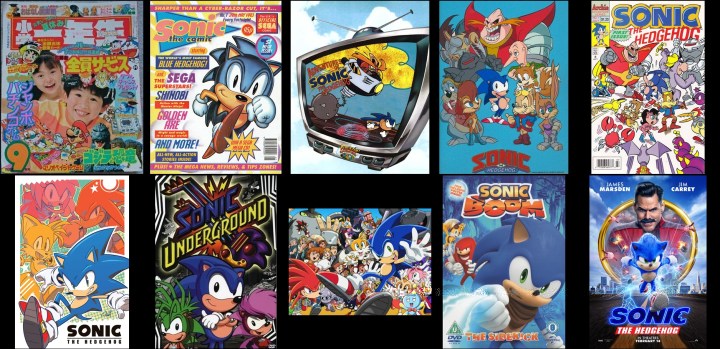(ThyBlackMan.com) While researching Alex Kidd and writing up a case on why Sega should’ve continued the series, I offered Alex becoming a part of the Sonic the Hedgehog universe. This got me thinking of retro games with deceptive storylines.
Now, I don’t mean subliminal messaging or anything insidious like that. I’m talking about games where the gameplay doesn’t really point to the world-building and lore of this game world you’re in.
Sonic the Hedgehog is the guiltiest of this crime and it all starts with the first Sonic game in 1991. I’m a gamer who loves lore, world-building, and timelines.
The Sonic franchise would develop all of this over time thanks in mammoth part to the Archie Comics series. However, the games themselves don’t really mention this dark world that Sonic lives in.

The First Two Sonic Games
Think of Sonic the Hedgehog like Star Wars. Old school purists like the old 90s games because they were fun and straight-forward. Modern fans tend to just like Sonic or discovered the franchise at a time when it was still decent enough gameplay.
They aren’t exactly the hardcore Sonic fans who love the franchise but will call the bad or mediocre games out.
The concept of Sonic the Hedgehog is enough for modern fans and the games are all just different games in the franchise. There’s a greater level of flexibility and acceptance of the new games from this pool.
I’ve never been the biggest fan of the first games of the main series but I love the backstory and comic adaptation of the franchise. The first two games give you this colorful, vibrant world with strange architecture and landforms.
Then there are robots everywhere and when you defeat them, little woodland creatures come out. Why are robots all of the place and why do they turn into animals once destroyed?
Well, there’s no reason behind the second reason. Hardware limitations of the time didn’t allow for complex animations would be my guess. An easier reason is that it’s a 90s video game.
I mean, the science behind warp pipes in Super Mario games was never really explained in the games. They just exist throughout the Mushroom Kingdom and oddly on other worlds.
As for the first question, Dr. Robotnik/Eggman is to blame. He’s just turning woodland creatures into robots across several games. These games never give an explicit reason as to why.
We know he’s after Chaos Emeralds but a bunch of squirrels and birds aren’t going to stop a mad scientist with robots and airships. Robotnik was just flexing on…who knows who.
Beyond the Console
Never mind that the games and the manual didn’t explain this madness, Sega licensed out the rights to Sonic the Hedgehog to DIC and Archie Comics.
Creatively, this was the best move for Sonic. Skip the afternoon cartoon series. It’s more in the vein of how the games were presented. What you want is Sonic SatAM or the Saturday morning cartoon that aired on ABC in 1993 and 1994.
This series and the Archie Comics starting with issue #60 or so really gave the backstory of Sonic some bite. Sonic and Tails exist in a dystopian world and are part of a rebel group to take down Robotnik.
While he works with a number of characters—most of which first make their appearances on SatAM and the comics—Sonic is the main field agent.
This is totally different from Sonic just being an adventurer and one of a few anthromorphic characters on Planet Mobius. It was confusing to see at eight but it made more sense and was more interesting than the story being told in the game!
As the comics have gone on over the decades, the characters are fleshed out a lot and Robotnik isn’t just cartoon evil, there’s a reason for him doing what he’s doing.
Ultimately, it didn’t matter why Robotnik was doing all of this because it was never really reflected in the games. Well, until the 3D era of the franchise started.
You could say that hardware and storytelling caught up. Animated cut scenes became a big thing in gaming by this time as well, so Sega could flesh out the story in Sonic games.
The constant in all of this has always been the storytelling via the comics. While there was a massive retcon in the late-2010s—because of the rights to characters created for the comic and SatAM—the plot progression in the comics always made the blue hedgehog’s adventures worth following.
Adaptations Are Necessary
For some game franchises, adaptations aren’t necessary unless it’s as a TV show or film. At that point, it’s just cashing in on a franchise’s popularity.
The thing is that games today are able to tell a full story or part of a story in the game. On the Sega Genesis, this was actually possible.
However, depending on the developer, the game might just focus more on the playing part than fleshing out plot and characters. For those games, an adaptation—usually a limited comic book—is necessary.
When a series runs for a long time to where your kids or nieces and nephews are playing a game in the franchise and the franchise is still vague about the world and the characters aren’t defined somewhat, yeah you need a cartoon, a lengthy comic, and maybe even a film.
Did Super Mario Bros need the 1993 film? No. It wasn’t close to faithful to the games but it was an interesting take on the franchise. That said, the Mario franchise could stand to have an adaptation that has a consistent story that builds on adventures.
Staff Writer; M. Swift
This talented writer is also a podcast host, and comic book fan who loves all things old school. One may also find him on Twitter at; metalswift.

















Leave a Reply